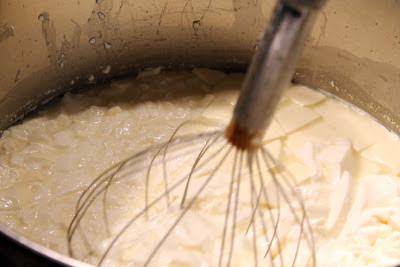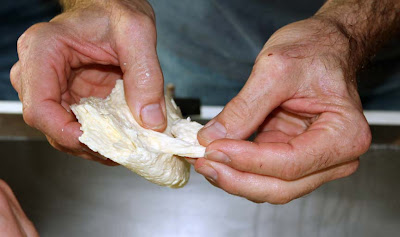Friday, November 30, 2012
Attending a cheese class
Last month Mike and I headed out to Massachusetts to attend a cheesemaking class taught by Jim Wallace, the technical advisor for New England Cheesemaking. Jim has traveled all over the world attending workshops and visiting with traditional cheesemakers. And people come from all over the world to attend Jim's classes. The gentleman in the light blue sweatshirt pictured above is a chef from Colombia. No, not Columbia, Missouri or Columbia, South Carolina. He's from the country of Colombia in South America! Mike and I flying out from Illinois was not a big deal, as there were several people there who had flown in from other states, as well as a few lucky souls who lived close enough to drive over to Jim's house for the class!
Obviously there is no way I can share with you everything that we learned in those two days, but I will tell you that half an hour into the first day, I knew it was worth the $375 that we each paid to attend. I've been making cheese for about ten years, and Mike has been making cheese for six. We've read books and followed recipes and tried to figure out why sometimes one thing worked and other times it didn't. We had so many questions about the science behind the curds and whey, and from one minute to the next in Jim's classes, there was one light bulb after another that kept going off in my head as I started to connect the jumble of dots that had been building in my head for ten years! My only regret is that I did not attend this class at least five years ago.
Mike took pages of notes. I took more than a hundred photographs. And by the end of the second day, my brain was so overfilled with information that it was as leaky as the Camembert that was draining! Here are a few highlights --
Most recipes tell you to cut the curds to a certain size -- like 1/4 inch or 1/8 inch -- and cutting curds diagonally is one of those chores that would just drive perfectionists crazy! But for both the cheddar and the toscano, Jim cut the curds into one-inch pieces, but instead of doing those crazy diagonal cuts, he then went to work with this gizmo that he fashioned from a whisk to look like the curd cutters that traditional cheesemakers use in Europe.
I tried using one of our whisks at home to cut the curds for a batch of feta, but some of the curds got too small, too fast, so I think I need a whisk with less metal thingies. And I should probably change the shape of the metal thingies the way Jim did with this one.
From the traditional cheddar class
Jim uses Jersey milk from a local farmer, which is why the curds look yellow. Don't they look divine!
Cheddaring is kind of like French milled soap. You let the curds set up, then you rip them apart and start over again putting the curds in the mold.
After cheddaring, class members helped to rip up the curds to prepare them for putting into the cheese press. That's Mike on the right. Chef Mario on the left has a little video recorder strapped to his head to capture every moment of the class for watching again later!
I have never seen a book that describe cheddaring very well, nor have I seen any that actually have pictures, so this was very helpful!
This is what the cheddar looked like the morning of the second class!
Since getting home, Mike has made two batches of traditional cheddar using tips he learned from Jim's classes. Previously, he had made farmhouse cheddar, which ironically omits the cheddaring step.
Over the weekend, we also made Camembert, a mold-ripened cheese, and Vacha Toscano, a tomme. Pictured here is one of the Camemberts after a few hours of draining. Mold-ripened cheeses had really been a challenge for me. In the past they turned out okay sometimes but not so great at other times. I learned in Jim's class that your success or failure with so many cheeses really lies in the aging -- or affinage -- which I had always assumed was my problem, but I had no idea what to do about it. I got some great ideas from Jim's class though, and I now have some Camembert aging beautifully.
Of the 17 different cheeses we have made in the past, we never made a tomme, but I am really looking forward to making one very soon. Jim's was delicious! Lucky for us, we still have a few goats in milk. Mike and I were saying that we should have taken this class in the spring when we are drowning in milk. We could have come home and started making cheese like crazy!
And this is Jim's cheese cave where he ages his creations. It is in a corner of his basement that stays naturally cool year round. He keeps mold-ripened cheeses in plastic containers to keep the humidity at the higher level that they need for proper affinage.
In addition to being blown away by Jim's class, I also fell in love with Shelburne Falls, MA. It is the most lovely little New England village. In fact, I'm writing a whole separate post about it!
And if you're a cheesemaker anywhere in the world, I highly recommend Jim's classes. He already has them scheduled for next spring. Click here to learn more.
Subscribe to:
Post Comments (Atom)









5 comments:
Looks amazing! What a great opportunity to learn from an expert like that. Isn't that great to sign up to do something and know so soon that you're getting your moneys worth...and probably more? Great pictures!
I've been to that town in MA. I went whitewater rafting and camping up there. It's so nice.
It looks fantastic. Love your photos. Great blog.
Hi Deborah and thanks for that nice write-up of the workshop.
Did you manage to put much of the workshop info to use before the critters dried off? Tell me how it all went.
Say Hi to Mike
We're putting lots of that info to use, Jim! My camembert feels like it's about ready to eat, and I have been working on an email to you with questions, but I need to get some cheddar details from Mike!
Post a Comment